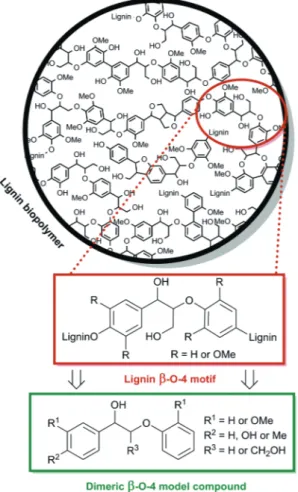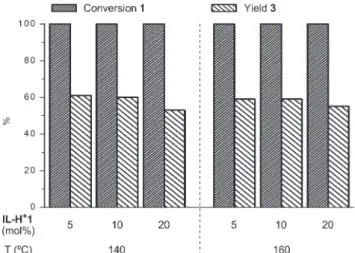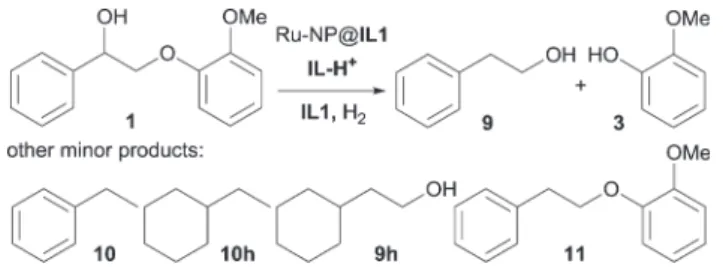Science &
Technology
PAPER
Cite this: Catal. Sci. Technol., 2016, 6, 1882
Received 14th September 2015, Accepted 16th October 2015 DOI: 10.1039/c5cy01554e www.rsc.org/catalysis
New insights into the catalytic cleavage of the lignin β -O-4 linkage in multifunctional ionic liquid media †
Martin Scott, ‡
abPeter J. Deuss, ‡
aJohannes G. de Vries,
acMartin H. G. Prechtl*
band Katalin Barta*
aIonic liquids are attractive reaction media for the solubilisation and depolymerisation of lignin into value- added products. However, mechanistic insight related to the cleavage of specific linkages relevant to effi- cient lignin depolymerisation in such solvents is still lacking. This study presents important insight into the scission of the most abundant lignin β -O-4 motif in Brønsted acidic ionic liquids. Using relevant model compounds, cleavage products were identified and undesired side reactions examined carefully. Stabiliza- tion of reactive intermediates was achieved in ionic liquids comprising both Brønsted acidic function and stabilized nanoparticles that comprise hydrogenation activity in order to suppress undesired side reactions.
Especially, the in situ hydrogenation of the aldehyde intermediate originating from the acid-catalysed cleavage of lignin beta-O-4 model compounds into more stable alcohols was investigated. This is the first time that such products have been systematically targeted in these multifunctional reaction media in rela- tion to lignin depolymerization.
Introduction
Before the widespread use of fossil carbon sources at the beginning of the 20th century, carbon-based compounds such as terpenes, methanol, and acetone were derived from wood.
1Due to the finite nature of fossil carbon resources, the focus has shifted again to the use of renewables.
2Utilization of lig- nocellulosic biomass for the chemical industry ideally requires valorisation of all its components.
2a,3Lignin, a major component of lignocellulosic biomass (15 – 35 wt%), could serve as a renewable source of aromatic bulk and fine chemicals.
3a,4However, depolymerization of lignin to aro- matic monomers has thus far proven to be challenging due to its amorphous and recalcitrant nature.
5In lignin, aromatic monomers are randomly cross-linked via C – C and C – O bonds (Fig. 1).
6The most abundant linkage is the β -O-4 alkyl – aryl ether.
5a,6Effective cleavage of this bond is seen as the key strategy for low-temperature depolymerisation of lignin into
desirable monomeric aromatic compounds in relatively high yields.
4c,7To this end, new strategies have been developed using representative β -O-4 model compounds, for which results are summarized in recent reviews.
3b,4c,5b,7b,cIn particu- lar, several studies have recently highlighted the need for sta- bilization of reactive cleavage products in order to suppress recondensation reactions that lead to decreased monomer yields.
8Ionic liquids (ILs) have many desirable characteristics for use as green reaction media, such as negligible vapour pres- sure, chemical inertness, tuneable polarity, acidity, basicity and tuneable miscibility with other solvents.
9Moreover, ILs have been reported as excellent solvents for the notoriously hard-to-dissolve lignin fractions
10and have shown great potential for the fractionation of lignocellulose components.
9c,11Therefore, the development of lignin depolymerisation method- ologies in ILs is very attractive.
One particularly intriguing field is the synthesis of nano- scale metal catalysts of controlled size and shape, namely metal(0) nanoparticles (M-NPs).
12M-NPs stabilized in ILs have been shown by us and others to possess a variety of attractive properties for use in catalysis
13and have found sev- eral interesting synthetic applications recently.
14A recent development showed that ionic liquids may act in particular cases not only as solvent, stabilizing and protecting agents for the formed nanoparticles, but selected ions also suitably act as very mild reducing agents.
13b,c,15In particular cases, even common ILs derived from imidazolium ([BMIM]NTf
2or
a
Stratingh Institute for Chemistry, Rijksunversiteit Groningen, Nijenborg 4, 9746 AS, Groningen, The Netherlands. E-mail: k.barta@rug.nl
b
Department of Chemistry, Institute of Inorganic Chemistry, University of Cologne, Greinstraße 6, 50939 Cologne, Germany. E-mail: martin.prechtl@uni-koeln.de
c
Leibniz-Insitut für Katalyse e.V. an der Universität, Rostock Albert-Einstein-Straße 29a, 18059 Rostock, Germany
† Electronic supplementary information (ESI) available: This includes detailed synthetic and analytical procedure as well as crystallographic data. See DOI:
10.1039/c5cy01554e
‡ Equal contribution.
Published on 21 October 2015. Downloaded by University of Cologne on 01/08/2016 19:05:49.
View Article Online
View Journal | View Issue




![Fig. 12 Conversion of 1 and yields of 2, 3 and 9 in the cleavage of compound 1 (0.1 mmol, 0.2 M) in a) IL1 and b) 60% 1,4-dioxane in IL1 at 140 ° C with IL-H + 1, 40 bar H 2 , Ru-NPs@IL1 (30 mol% [Ru] (a) and 7.5 mol% [Ru] (b)).](https://thumb-eu.123doks.com/thumbv2/1library_info/3643300.1502907/7.892.468.820.66.399/fig-conversion-yields-cleavage-compound-mmol-dioxane-nps.webp)